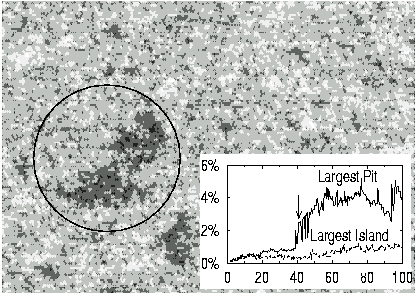 On the right, you see a picture of a surface which is starting along a bad
path. Light colors represent atoms in high layers (isolated atoms and clumps
we call islands), and dark colors represent atoms in lower layers (vacancies
and pits). Most of the surface is pretty flat, but there is a big dark-grey
pit! This pit represents a region of the surface which has lagged behind by
a whole monolayer: pits like these will eventually lead the surface to
become rough.
On the right, you see a picture of a surface which is starting along a bad
path. Light colors represent atoms in high layers (isolated atoms and clumps
we call islands), and dark colors represent atoms in lower layers (vacancies
and pits). Most of the surface is pretty flat, but there is a big dark-grey
pit! This pit represents a region of the surface which has lagged behind by
a whole monolayer: pits like these will eventually lead the surface to
become rough.
Experimentalists have various ways to test whether their surfaces are growing
layer by layer (flat), or 3D (rough). One way is by using STM to directly
image the layers; another way is to scatter something off the surface and
look for oscillations in the ``Anti-phase intensity''.
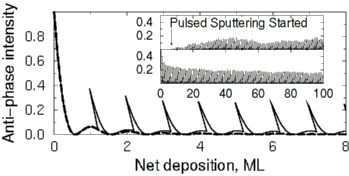 If a layer completes and forms a perfectly flat surface, you get anti-phase
intensity of one; if the surface is rough (or flat but half-covered with
a new layer), the antiphase intensity goes to zero.
The dashed line in the picture on the left shows the anti-phase intensity
for our computer model. (We're growing on a platiunum (111) surface at
130K at one layer per second, using KMC with EMT potentials.) It goes
away quickly.
If a layer completes and forms a perfectly flat surface, you get anti-phase
intensity of one; if the surface is rough (or flat but half-covered with
a new layer), the antiphase intensity goes to zero.
The dashed line in the picture on the left shows the anti-phase intensity
for our computer model. (We're growing on a platiunum (111) surface at
130K at one layer per second, using KMC with EMT potentials.) It goes
away quickly.
The spiky, solid line is our proposed new method for growing surfaces. We
suggest using pulsed sputtering. If we sputter (remove atoms) from the
surface just after a complete layer has been laid down, the extra atoms
and islands can be removed without digging new pits: this smooths the surface.
The spikes show how the surface gets smoother (bigger antiphase intensity)
each time we sputter: the smaller inset graph shows that it stays smooth
even after a hundred layers (at least on the computer!). It also shows
that a rough surface can be made smooth by using our pulsed sputtering method.
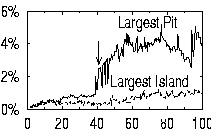 It's important to pick the right time to sputter. The big pit in the top
picture formed even though we did pulsed sputtering. Our surface stayed
flat for forty layers before the pit formed. Can we time things so as to
make layer-by-layer growth last forever?
It's important to pick the right time to sputter. The big pit in the top
picture formed even though we did pulsed sputtering. Our surface stayed
flat for forty layers before the pit formed. Can we time things so as to
make layer-by-layer growth last forever?
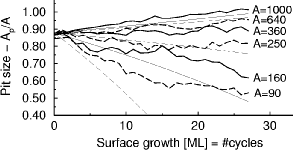 The reason that we lasted for forty layers is that small pits tend to shrink:
only big pits grow. We tested this by starting with pits of various sizes,
and watching them grow or shrink. Averaging over many runs we get the picture
on the right. By timing our
pulses after every 1.15 layers, we find that a pit has to make it to
~350 atoms big before it'll keep growing. We then change our timing to
try to make pits of all sizes shrink.
The reason that we lasted for forty layers is that small pits tend to shrink:
only big pits grow. We tested this by starting with pits of various sizes,
and watching them grow or shrink. Averaging over many runs we get the picture
on the right. By timing our
pulses after every 1.15 layers, we find that a pit has to make it to
~350 atoms big before it'll keep growing. We then change our timing to
try to make pits of all sizes shrink.
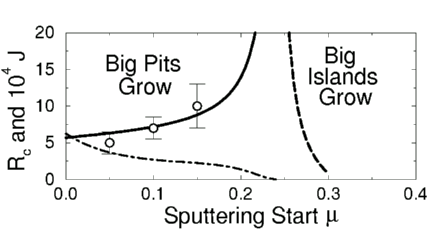 This graph shows our theory curve, for how big a pit needs to be before
it will grow and mess up our surface (the critical pit size Rc).
If we start sputtering each time we deposit 1.15 layers of atoms (0.15 on
the horizontal axis), we see that it needs to have a radius around 10 (around
the same as the ~350 atoms we saw above). By estimating the growth parameters
and developing a theory for the fluctuations in island size, we are able to
predict that growing at 0.24 (about one and a quarter layers deposited, then
1/4 layer sputtered away) we could grow layer-by-layer forever!
This graph shows our theory curve, for how big a pit needs to be before
it will grow and mess up our surface (the critical pit size Rc).
If we start sputtering each time we deposit 1.15 layers of atoms (0.15 on
the horizontal axis), we see that it needs to have a radius around 10 (around
the same as the ~350 atoms we saw above). By estimating the growth parameters
and developing a theory for the fluctuations in island size, we are able to
predict that growing at 0.24 (about one and a quarter layers deposited, then
1/4 layer sputtered away) we could grow layer-by-layer forever!
James P. Sethna, sethna@lassp.cornell.edu
![]() Statistical Mechanics: Entropy, Order Parameters, and Complexity,
now available at
Oxford University Press
(USA,
Europe).
Statistical Mechanics: Entropy, Order Parameters, and Complexity,
now available at
Oxford University Press
(USA,
Europe).